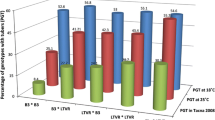Summary
The development of potato cultivars having acceptable chipping quality after cold storage is important because it reduces costs to growers while ensuring continuity of supply to processors throughout the year. Over 5100 single-hill progenies were planted to select for cold chippers. A breeding procedure for selecting and evaluating these progenies for cold chipping ability was used, and 38 desirable genotypes were identified. These selections were increased in the second clonal generation and evaluated for yield, specific gravity, and seven chipping treatments of varying storage duration/temperature/reconditioning duration and were compared to standard chipping cultivars Atlantic, Monona, Norchip, and Snowden. Twenty-two selections yielded ≥ Norchip the highest yielding cultivar, while 15 selections had a specific gravity ≥ Atlantic, the highest specific gravity cultivar. Snowden was the best chipping cultivar overall and some selections were not significantly different than Snowden. Overall, nine selections combined high yield and specific gravity with the ability to produce attractive chips from 4° C. Single-hill selection for cold chipping could potentially save four years in the breeding process by the identification of good parents, the recycling of good parental cross combinations, and the evaluation of progeny for chipping earlier in the breeding program.
Similar content being viewed by others
References
Accatino, P.L., 1973. Inheritance of the potato chip color at the diploid and tetraploid levels of ploidy. University of Wisconsin, Madison, Ph.D. Thesis. p. 62.
Blomquist, A.W. & F.I. Lauer, 1962. First clonal generation potato progeny performance at two Minnesota locations. Am. Potato J. 39: 460–463.
Brown, J., P.D.S. Caligari & G.R. Mackey, 1987. The repeatability of progeny means in the early generation of a potato breeding programme. Ann. Appl. Biol. 110: 365–370.
Brown, J., P.D.S. Caligari, G.R. Mackey & G.E.L. Swan, 1984. The efficiency of seedling selection by visual preference in a potato breeding programme. J. Agric. Sci. 103: 339–346.
Gunningham, C.E. & F.J. Stevenson, 1963. Inheritance of factors affecting potato chip color and their association with specific gravity. Am. Potato J. 40: 253–265.
Davies, H.T. & G.R. Johston, 1974. Reliability of potato selection in the first clonal generation. Am. Potato J. 51: 8–11.
Denny, F.E. & N.C. Thornton, 1941. Potato varieties: sugar forming characteristics of tubers in cold storage and suitability for production of potato chips. Contrib. Boyce Thompson Inst. 12: 217–252.
Eisenhauer, M., 1993. Chip company perspective: Quality is important to consumers. Valley Potato Grower 108: 26–27.
Ewing, E.E., 1974. Potato chip color. Am. Potato J. 51: 242–243.
Ewing, E.E., A.H., Senesac & J.B. Sieczka, 1981. Effects of short periods of chilling and warming on potato sugar content and chipping quality. Am. Potato J. 58: 633–647.
Gould, W.A., B. Hair & A. Baroudi, 1979. Evaluation of potato cultivars before and after storage regimes for chipping. Am. Potato J. 56: 133–144.
Habib, A.T. & H.D. Brown, 1956. Factors influencing the color of potato chips. Food Technol. 10(7): 332–336.
Habib, A.T. & H.D. Brown, 1957. Role of reducing sugars and amino acids in the browning of potato chips. Food Technol. 11(2): 85–89.
Lulai, E.C. & P.H. Orr, 1979. Influence of potato specific gravity on yield and oil content of chips. Am. Potato J. 56: 379–389.
National Potato Council, 1992. Potato statistical yearbook p. 32–33.
Neele, A.E.F., J.H.M. Barten & K.M. Louwes, 1988. Effects of plot size and selection intensity on efficiency of selection in the first clonal generation of potato. Euphytica S: 27–35.
Neele, A.E.F. & K.M. Louwes, 1989. Early selection for chip quality and dry matter content in potato seedling populations in greenhouse and screenhouse. Potato Res. 32: 293–300.
Peterson, L.C. & R.L. Plaisted, 1960. Recurrent selection for high specific gravity. p. 154–156. In: 30th Ann. Report to Cooperators. The National Potato Breeding Program.
Ross, H., 1986. Potato breeding — problems and perspectives. Verlag Paul Parcy. Berlin and Hamburg.
Shallenberger, R.S., O. Smith & R.H. Treadway, 1959. Role of sugars in the browning reaction in potato chips. J. Agric. Food Chem. 7: 274–277.
Simmonds, N.W., 1979. Principles of crop improvement. Longman, London and New York.
Smith, O., 1951. Effect of specific gravity and partial drying of potato slices on yield, color, oil content and time of frying chips. Natl. Potato Chip Inst., Fats and Oils Article 6: 1–2.
Stevenson, F.J. & C.E. Cunningham, 1961. Chip color in relation to potato storage. Am. Potato J. 38: 105–113.
Tai, G.C.C., 1974. A method for quantitative genetic analysis of early clonal generation seedlings of an asexual crop with special application to a breeding population of the potato (Solanum tuberosum L.) Theor. Appl. Genet. 45: 150–156.
Tai, G.C.C., 1975. Effectiveness of visual selection for early clonal generation seedlings of potato. Crop Sci. 15: 15–18.
Tai, G.C.C., 1979. An interval estimation of expected response to selection. Theor. Appl. Genet. 54: 273–275.
Tai, G.C.C. & D.A. Young. 1984. Early generation selection for important agronomic characteristics in a potato breeding population. Am. Potato J. 61: 419–434.
Talburt, W.F. & O. Smith, 1967. Potato processing. AVI, Westport, Conn.
Thill, C.A. & S.J. Peloquin, 1994. Inheritance of potato chip color at the 24-chromosome level. Am. Potato J. 71: 629–646.
Young, D.A. & H.B. Cannon, 1964. Field plot techniques for the estimation of specific gravity of potatoes. Am. Potato J. 41: 349–356.
Author information
Authors and Affiliations
Rights and permissions
About this article
Cite this article
Thill, C.A., Peloquin, S.J. A breeding method for accelerated development of cold chipping clones in potato. Euphytica 84, 73–80 (1995). https://doi.org/10.1007/BF01677559
Received:
Accepted:
Issue Date:
DOI: https://doi.org/10.1007/BF01677559




